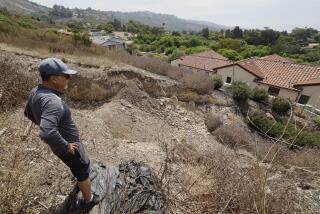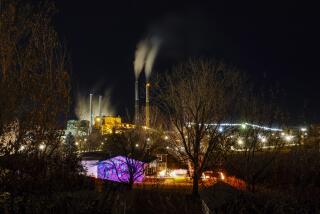Northwest’s Power Supply Dries Up
WENATCHEE, Wash. — Eight miles outside the town that calls itself “the buckle of the power belt,” there’s a scene to frighten any Californian looking north for rescue from blackouts this summer.
On a bluff above the mighty Columbia River, one of the nation’s biggest sources of electricity, utility workers are installing 26 trailer-size generators.
The diesel-burning boxes, hooked to an aerial mesh of power lines, will help do this year what the river winding below cannot: satisfy the region’s demand for electricity.
“We wouldn’t be doing this if the river were producing anywhere near normal this year,” said Wayne Wright, spokesman for the Chelan County Public Utility District, which spent $31 million to buy the diesel generators.
Here is proof that the largess of the nation’s power belt has vanished. The Pacific Northwest is scrambling to find enough electricity for itself, with none left over to help feed the grid running south to California.
The reason is simple, and wholly out of human hands. Scant snow and rain in the northern Rockies this winter has cut by nearly half the average runoff to the Columbia River. As the spring melt begins, the river flow is expected to be the lowest since 1977. And water equals power at the 11 dams spanning the Columbia.
“If it turns out to be 58% of the water, we’re going to be able to generate 58% of the electricity,” said Dave Lyngholm, who works upstream of Wenatchee managing the biggest power plant in North America: Grand Coulee Dam.
Deep beneath the dam, the sheer weight and pressure of channeled river water moves 500-ton water wheels, which make six-story steel shafts spin, propelling a magnetized rotor past copper bars and producing a fast-as-light stream of electrons--electricity.
In an average year, Grand Coulee’s generators can tap into 65 million acre-feet of water--almost as much as all the runoff in California. This year, about 38 million acre-feet are expected to flow down the Columbia.
Those numbers foretell blackouts in California. For a generation, the state has counted on the Pacific Northwest for up to 11% of its power supply, especially in early summer as spring runoff peaks.
Last year, as California’s energy supply fell short, Pacific Northwest suppliers often delivered--on short notice, albeit at steep prices--the several hundred or thousand megawatts that spared the state from blackouts.
Months later, with no new major power plants in California yet running, the drought that has gripped the Pacific Northwest is akin to the loss of several big power plants.
“It’s going to be a major factor that we’re going to have to manage around all summer long,” said Jim McIntosh, chief of grid operations for the California Independent System Operator, which oversees the transmission system serving 75% of the state.
There will be far fewer megawatts along the main transmission line connecting the West from Canada to Mexico. There will be a bidding war for those megawatts, and California may lose.
Under California’s 1996 deregulation law, the private companies that own power plants in the state have no obligation to sell their power here. Higher prices in other states could draw that power elsewhere.
Electricity traders forecast that in July and August, power purchased at peak times will cost $510 per megawatt-hour at the Oregon border, $635 at the Arizona border and $385 in Northern California. A megawatt-hour is roughly enough electricity for 750 to 1,000 homes for an hour.
“Power prices are higher in the Northwest,” said Severin Borenstein, director of the University of California Energy Institute in Berkeley. “They’re going to send it [power] to the Northwest. That’s how markets work.”
The California Energy Commission calculates that the state has guaranteed the delivery of 1,800 megawatts of power from the Pacific Northwest this summer through contracts. That compares to the 3,000 to 5,000 megawatts that California utilities typically imported in previous years.
“We don’t expect surplus power this year from the Pacific Northwest,” said commission spokeswoman Claudia Chandler.
Production at California’s own hundreds of river-run turbines will be down, too.
The Sierra snowpack, which fills the Sacramento River and key reservoirs, holds an estimated 60% of the average water content.
But at most, hydroelectric power makes up 20% of California’s overall power supplies--compared to 85% in Washington and Oregon. There, where water and power are essentially the same, the effect of the drought magnifies across the economy and the landscape.
The Bonneville Power Administration, a federal agency that sells the electricity generated at 29 dams on the Columbia and its tributaries, is paying some electricity-intensive aluminum companies to stop producing and farmers not to irrigate.
Agency officials figure that’s cheaper than going to the spot market to buy power for its customers when its own production capacity falls short.
“Low water combined with a tight wholesale power market and skyrocketing power prices is a devastating combination,” BPA administrator Stephen Wright said this week. He warned BPA customers that rates could soon double without a widespread crash program in conservation, including the shutdown of the aluminum industry for as long as two years.
Outside Wenatchee, only two of five production lines are running at the big Alcoa plant, where fantastic jolts of electricity turn mineral powder to aluminum. Most of the 640 employees are working, though--many at odd jobs or ergonomic and environmental projects.
They are getting paid with the money BPA pays Alcoa for not consuming electricity. And there’s unease about the future.
“For us, electricity doesn’t run lights,” said plant spokesman Jim Baxter. “It’s a resource and raw material. To me, the real story is the potential for lost long-term employment in the Pacific Northwest if we don’t have the energy to run these plants.”
Others are worried about next month. In Wenatchee, the heart of Washington’s apple country, more than 200 orchard owners gathered recently to hear that soon they may be barred from using Columbia River water, under a 1980 rule meant to guarantee a minimum flow in dry years.
“I cannot afford to go without water,” said Bob Peterson, a grower who complained of four bad years of apple prices. “One more year and I’m out of business.”
Several growers accused the operators of Grand Coulee and other dams of releasing too much water to make power for California this winter--a season when California traditionally sends power north to heat homes in Washington and Oregon.
Grand Coulee managers say they simply generated electricity from water they had to release anyway for endangered salmon.
Future runs of salmon on the Columbia and its tributaries may not be so fortunate. Federal officials are debating whether to suspend a practice known as spilling that releases water around dams--avoiding powerhouses--as a safer way to wash young salmon to the ocean.
Chris Zimmer, a spokesman for a Seattle-based group of fishermen and conservationists, called the Columbia River system “sick.”
“It only works for fish and people and industry when Mother Nature blesses us with high water years,” he said.
More to Read
Sign up for Essential California
The most important California stories and recommendations in your inbox every morning.
You may occasionally receive promotional content from the Los Angeles Times.










